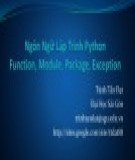
Trịnh Tấn Đạt
Đại Học Sài Gòn
trinhtandat@sgu.edu.vn
http://sites.google.com/site/ttdat88


Nội Dung
Giới thiệu và cài đặt
Cấu trúc dữ liệu của pandas
Series và Dataframe
Bài tập

Cài đặt
“pandas” là thư viện mở rộng từ numpy, chuyên để xử lý dữ liệu cấu trúc dạng
bảng (có thể dùng để đọc file excel hoặc csv)
Tên “pandas” là viết tắt từ “panel data”
Để cài đặt module pandas dùng lệnh:
pip install pandas
https://pandas.pydata.org/docs/user_guide/index.html
https://pandas.pydata.org/docs/reference/index.html

Đặc điểm
Đọc dữ liệu từ nhiều định dạng
Liên kết dữ liệu và tích hợp xử lý dữ liệu bị thiếu
Xoay và chuyển đổi chiều của dữ liệu dễ dàng
Tách, đánh chỉ mục và chia nhỏ các tập dữ liệu lớn dựa trên nhãn
Có thể nhóm dữ liệu cho các mục đích hợp nhất và chuyển đổi
Lọc dữ liệu và thực hiện query trên dữ liệu
Xử lý dữ liệu chuỗi thời gian và lấy mẫu
















![Đề thi cuối học kì 2 môn Cấu trúc dữ liệu và giải thuật [kèm đáp án/mới nhất]](https://cdn.tailieu.vn/images/document/thumbnail/2025/20251014/lakim0906/135x160/89711760416179.jpg)


![Tài liệu Nhập môn Học máy và Khai phá Dữ liệu [chuẩn nhất]](https://cdn.tailieu.vn/images/document/thumbnail/2025/20251001/kimphuong1001/135x160/531759303870.jpg)






